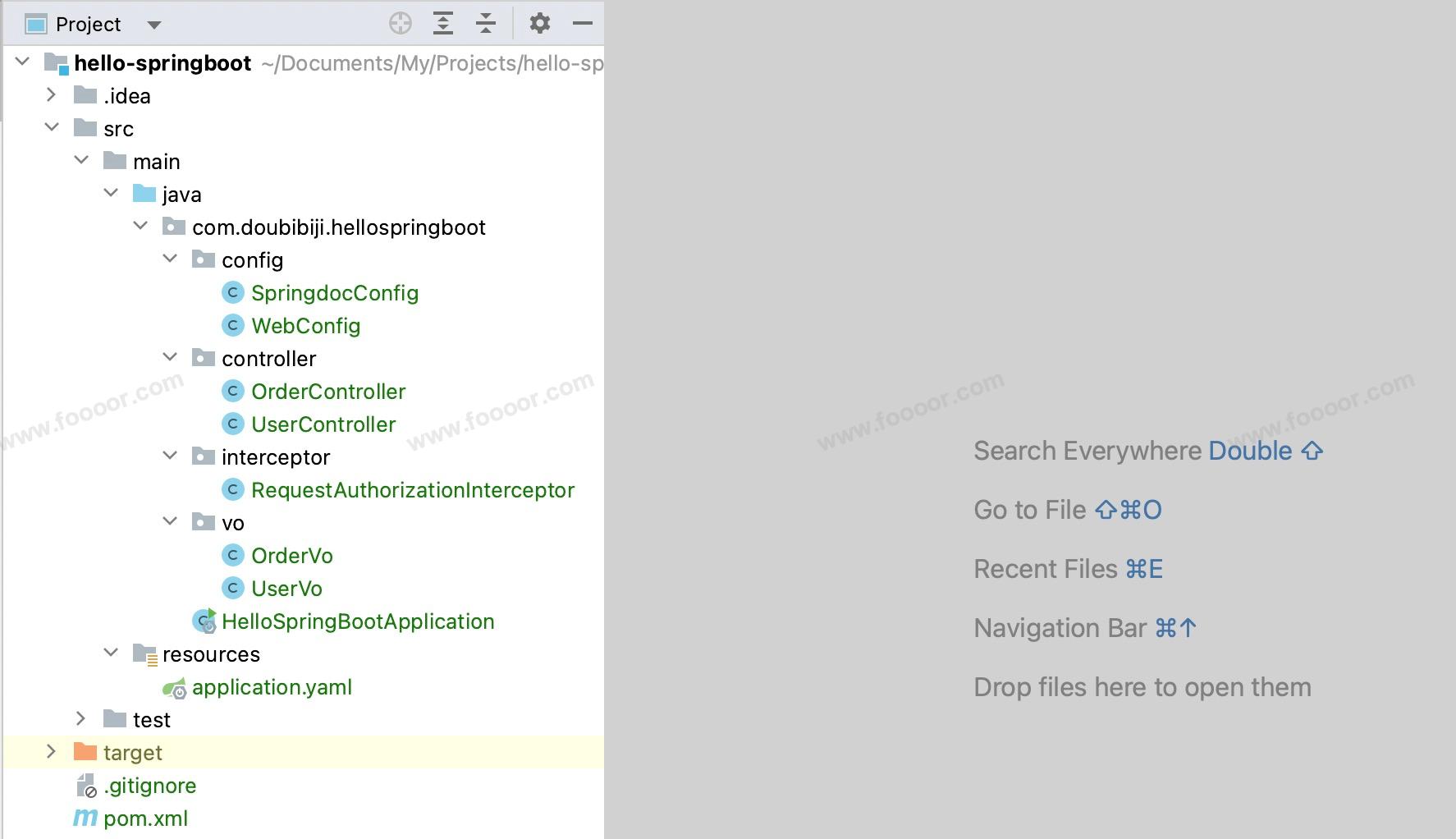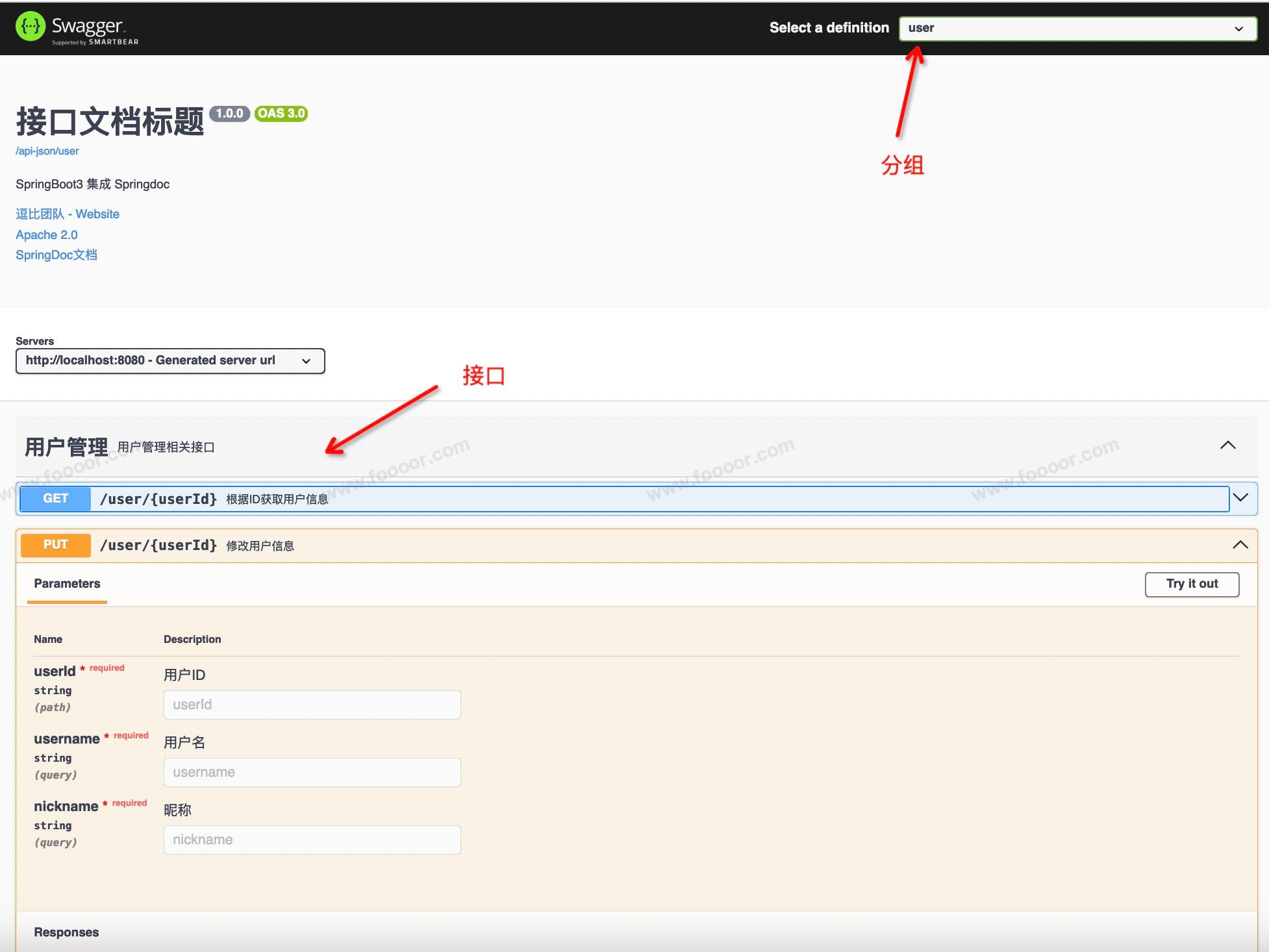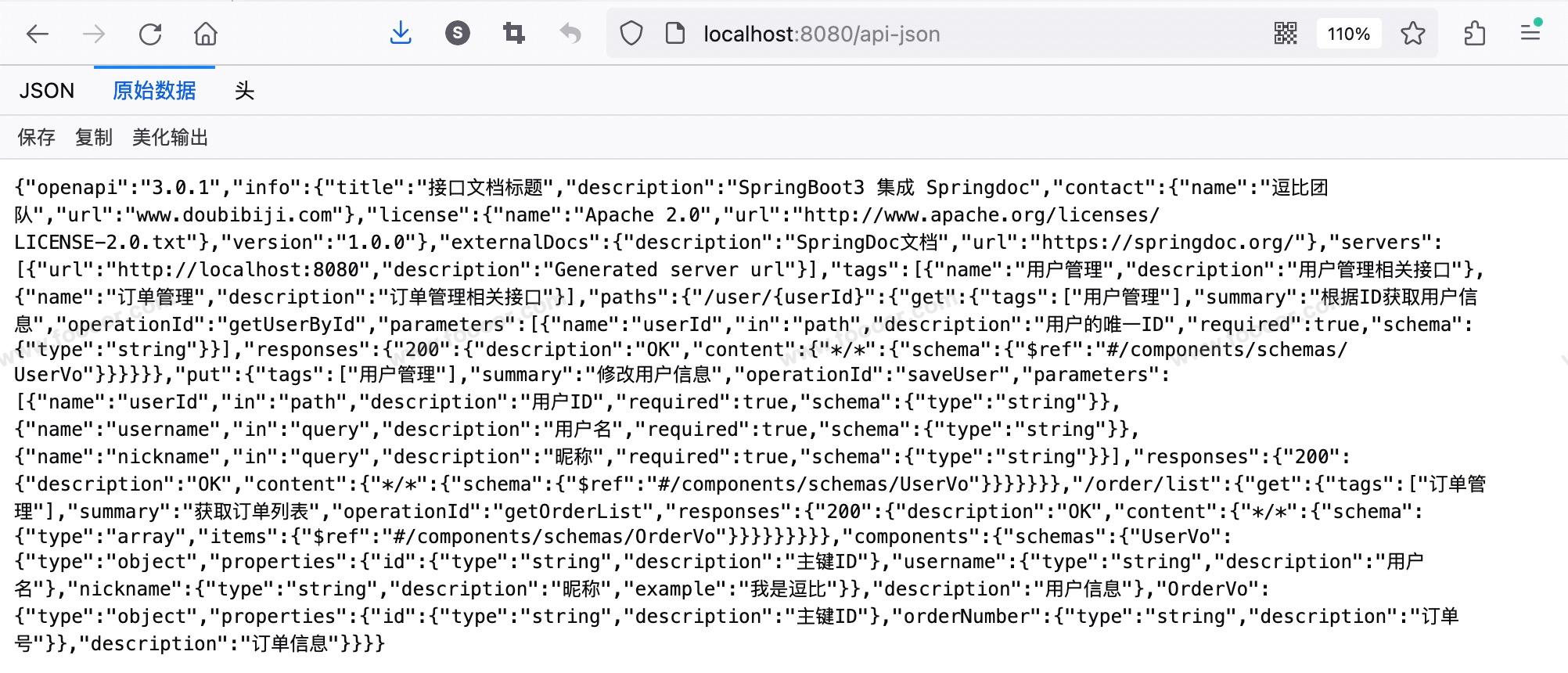Appearance
SpringBoot3教程 - 18 SpringBoot集成Springdoc
当前主流的开发模式是前后端分离,这样前端在开发的时候想要知道后端接口的信息,就需要一个 API 文档,由于开发任务繁重,而且接口随时可能更新,如果手动来编写或更新 API 文档肯定累死人,所以有一个自动生成服务器接口文档的工具就很有必要了。
Swagger就是干这个的,不仅可以查看接口的信息,还可以在线测试接口。
但是使用 SpringBoot3,Swagger的支持有问题,所以我们可以使用 Spring 官方的推出的 springdoc-openapi。Springdoc 使用 OpenAPI 3.0 规范,这与 Swagger 使用的 OpenAPI 规范一致。实际上,Springdoc 生成的文档可以直接用于 Swagger UI 展示。
Springdoc官网:https://springdoc.org/
下面介绍一下如何在 SpringBoot项目中集成Springdoc。
18.1 创建SpringBoot项目
创建项目,不多说了。
18.2 添加依赖
在项目的 pom.xml 文件中添加如下依赖:
xml
<!-- springdoc -->
<dependency>
<groupId>org.springdoc</groupId>
<artifactId>springdoc-openapi-starter-webmvc-ui</artifactId>
<version>2.5.0</version>
</dependency>18.3 配置application.yml
在 application.yaml 中添加如下配置,生产环境不应该再暴漏 API 文档了,所以可以在 application-dev.yaml 文件中进行配置,在开发环境中使用就可以了。
yaml
springdoc:
swagger-ui:
path: /api-ui
enabled: true
api-docs:
enabled: true
path: /api-json
groups:
enabled: true
# 配置需要生成接口文档的扫描包
packages-to-scan: com.doubibiji.hellospringboot.controller后面可以通过 /api-ui 和 /api-json 来访问 API 接口页面。
18.4 配置文档信息
在 com.doubibiji.hellospringboot.config 包下新建一个 Springdoc 的配置类,对接口文档的一些信息进行说明,同时对接口进行分组。
配置如下:
java
package com.doubibiji.hellospringboot.config;
import io.swagger.v3.oas.models.ExternalDocumentation;
import io.swagger.v3.oas.models.OpenAPI;
import io.swagger.v3.oas.models.info.Contact;
import io.swagger.v3.oas.models.info.Info;
import io.swagger.v3.oas.models.info.License;
import org.springdoc.core.models.GroupedOpenApi;
import org.springframework.context.annotation.Bean;
import org.springframework.context.annotation.Configuration;
@Configuration
public class SpringdocConfig {
@Bean
public GroupedOpenApi userApi() {
return GroupedOpenApi.builder()
.group("user")
.pathsToMatch("/user/**") // /user/**的接口分为一组
.build();
}
@Bean
public GroupedOpenApi orderApi() {
return GroupedOpenApi.builder()
.group("order")
.pathsToMatch("/order/**") // /order/**的接口分为一组
.build();
}
@Bean
public OpenAPI openAPI() {
return new OpenAPI()
.info(apiInfo())
.externalDocs(new ExternalDocumentation()
.description("SpringDoc文档")
.url("https://springdoc.org/"));
}
private Info apiInfo() {
return new Info()
.title("接口文档标题")
.description("SpringBoot3 集成 Springdoc")
.version("1.0.0")
.contact(new Contact()
.name("逗比团队")
.url("www.doubibiji.com")
)
.license(new License()
.name("Apache 2.0")
.url("http://www.apache.org/licenses/LICENSE-2.0.txt")
);
}
}18.5 排除拦截
在我们的项目中,可能会配置拦截器,拦截除登录注册外的请求,所以需要针对 Springdoc 相关的请求排除在外,否则访问会被拦截,导致无法访问。
如果你的项目中有拦截器,一定要注意一下拦截配置。
假设我有一个拦截器 ,这里拦截所有的请求:
java
package com.doubibiji.hellospringboot.interceptor;
import jakarta.servlet.http.HttpServletRequest;
import jakarta.servlet.http.HttpServletResponse;
import lombok.extern.slf4j.Slf4j;
import org.springframework.stereotype.Component;
import org.springframework.web.servlet.HandlerInterceptor;
@Slf4j
@Component
public class RequestAuthorizationInterceptor implements HandlerInterceptor {
@Override
public boolean preHandle(HttpServletRequest request, HttpServletResponse response, Object handler) throws Exception {
String servletPath = request.getServletPath();
log.info("request path:{}", servletPath);
// 拦截所有请求
throw new RuntimeException();
}
}配置拦截器,不拦截 Springdoc 相关的请求:
java
package com.doubibiji.hellospringboot.config;
import com.doubibiji.hellospringboot.interceptor.RequestAuthorizationInterceptor;
import org.springframework.beans.factory.annotation.Autowired;
import org.springframework.context.annotation.Configuration;
import org.springframework.web.servlet.config.annotation.InterceptorRegistry;
import org.springframework.web.servlet.config.annotation.WebMvcConfigurer;
import java.util.ArrayList;
import java.util.List;
@Configuration
public class WebConfig implements WebMvcConfigurer {
@Autowired
private RequestAuthorizationInterceptor requestAuthorizationInterceptor;
@Override
public void addInterceptors(InterceptorRegistry registry) {
List<String> excludeInterceptorPath = new ArrayList<>();
// API文档访问接口
excludeInterceptorPath.add("/api-ui/**");
excludeInterceptorPath.add("/api-json/**");
// swagger接口
excludeInterceptorPath.add("/swagger-ui.html");
excludeInterceptorPath.add("/swagger-ui/**");
excludeInterceptorPath.add("/swagger-resources");
excludeInterceptorPath.add("/swagger-resources/**");
excludeInterceptorPath.add("/v3/api-docs/**");
excludeInterceptorPath.add("/docs");
// 拦截器,排除拦截
registry.addInterceptor(requestAuthorizationInterceptor)
.addPathPatterns("/**").excludePathPatterns(excludeInterceptorPath);
}
}18.6 编写接口
下面编写接口,在接口、参数、返回值相关的类型添加相关的注解,用于生成 API 文档。
UserController:
java
package com.doubibiji.hellospringboot.controller;
import com.doubibiji.hellospringboot.vo.UserVo;
import io.swagger.v3.oas.annotations.Hidden;
import io.swagger.v3.oas.annotations.Operation;
import io.swagger.v3.oas.annotations.Parameter;
import io.swagger.v3.oas.annotations.Parameters;
import io.swagger.v3.oas.annotations.tags.Tag;
import org.springframework.web.bind.annotation.*;
@Tag(name = "用户管理", description = "用户管理相关接口")
@RestController
@RequestMapping("/user")
public class UserController {
// 接口描述
@Operation(summary = "根据ID获取用户信息")
@GetMapping("/{userId}")
public UserVo getUserById(@Parameter(name="userId", required = true, description = "用户的唯一ID") @PathVariable String userId) {
return new UserVo("user_001", "doubi", "逗比");
}
/**
* 多个参数也可以这样写
*/
@Operation(summary = "修改用户信息")
// 参数描述
@Parameters({
@Parameter(name = "userId", required = true, description = "用户ID"),
@Parameter(name = "username", required = true, description = "用户名"),
@Parameter(name = "nickname", description = "昵称")
})
@PutMapping("/{userId}")
public UserVo saveUser(@PathVariable String userId, String username, String nickname) {
return new UserVo(userId, username, nickname);
}
/**
* 不想在API中暴漏接口,可以通过@Hidden隐藏
* 不影响接口访问
*/
@Hidden
@GetMapping(value = "/test")
public String test() {
return "Hello!";
}
}OrderController:
java
package com.doubibiji.hellospringboot.controller;
import com.doubibiji.hellospringboot.vo.OrderVo;
import io.swagger.v3.oas.annotations.Operation;
import io.swagger.v3.oas.annotations.tags.Tag;
import org.springframework.web.bind.annotation.GetMapping;
import org.springframework.web.bind.annotation.RequestMapping;
import org.springframework.web.bind.annotation.RestController;
import java.util.ArrayList;
import java.util.List;
@Tag(name = "订单管理", description = "订单管理相关接口")
@RestController
@RequestMapping("/order")
public class OrderController {
@Operation(summary = "获取订单列表")
@GetMapping("/list")
public List<OrderVo> getOrderList() {
List<OrderVo> orderVoList = new ArrayList<>();
orderVoList.add(new OrderVo("order_001", "order_2024062601010101"));
orderVoList.add(new OrderVo("order_001", "order_2024062601010102"));
return orderVoList;
}
}返回的实体类UserVo:
java
package com.doubibiji.hellospringboot.vo;
import io.swagger.v3.oas.annotations.media.Schema;
import lombok.AllArgsConstructor;
import lombok.Data;
@Data
@AllArgsConstructor
@Schema(description= "用户信息")
public class UserVo {
@Schema(description = "主键ID")
private String id;
@Schema(description = "用户名")
private String username;
@Schema(description = "昵称", example = "我是逗比")
private String nickname;
}返回的实体类OrderVo:
java
package com.doubibiji.hellospringboot.vo;
import io.swagger.v3.oas.annotations.media.Schema;
import lombok.AllArgsConstructor;
import lombok.Data;
@Data
@AllArgsConstructor
@Schema(description= "订单信息")
public class OrderVo {
@Schema(description = "主键ID")
private String id;
@Schema(description = "订单号")
private String orderNumber;
}整个项目的结构:

18.7 访问测试
访问 API 文档的页面,最终的效果如下。
访问:http://localhost:8080/api-ui

访问:http://localhost:8080/api-json

Springdoc 注解的一些使用,这里就不详细介绍了,大家可以百度一下。
内容未完......